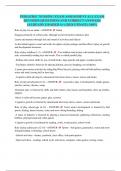PEDIATRIC NURSING EXAM ASSESSMENT ALL EXAM
REVISION QUESTIONS AND CORRECT ANSWERS
(ALREADY GRADED A+) (2024 UPDATE) 100%
Role of play for an infant - ANSWER- Infant
Engages primarily in solitary play, although social interaction enhances play
Learns and matures through feel and sound of activities and objects
As the infant begins to crawl and walk, the sphere of play enlarges and the effect of play on growth
and development increases.
Role of play toddlers (1-3) - ANSWER- -Two toddlers tend to play with similar objects side by
side, occasionally trading toys and words. This is called parallel play.
-Refines fine motor skills by use of cloth books, large pencils and paper, wooden puzzles
-Facilitates imitative behavior by playing kitchen, grocery shopping, toy telephone
-Learns gross motor activities by riding Big Wheel tricycle, playing with soft ball and bat, molding
water and sand, tossing ball or bean bag
-Cognitive skills develop by educational television shows, music, stories and books
Role of play preschoolers (3-6) - ANSWER- -Associative play is facilitated by simple games,
puzzles, nursery rhymes, songs
-Dramatic play is fostered by dolls and doll clothes, play houses and hospitals, dress up clothes,
puppets
-Stress is relieved by pens, paper, glue, scissors
-Cognitive growth is fostered by educational television shows, music, stories and books
Role of play school-age (6-12) - ANSWER- Gross motor development is fostered by ball
sports, skating, dance lessons, water and snow skiing/boarding, biking
-A sense of industry is fostered by playing a musical instrument, gathering collections, starting
hobbies, playing board and video games
-Cognitive growth is facilitated by reading, crafts, word puzzles, school-work
Role of play adolescent (12-18) - ANSWER- Sports—ball games, gymnastics, water and snow
skiing/boarding, swimming, school sports
-School activities—drama, yearbook, class office, club participation
-Quiet activities—reading, school work, television, computer, video games, texting, music
,Planning Nursing Interventions - ANSWER- Encourage play while hospitalized
Play is important to encourage development.
Include social interaction when hospitalized
Roommates
Play room/recreation room activities
Pediatric Differences in electrolyte balance - ANSWER- •Percentage of body weight composed
of water varies with age
•Infants have high daily fluid requirement with little fluid volume reserve
•Vulnerable to dehydration
•Infants and children under 2 years lose greater proportion of fluid each day
•More dependent on adequate intake
extracellular fluid - ANSWER- intravascular fluid (fluid in blood vessels) and interstitial fluid
(fluid between cells and outside the blood and lymphatic vessels).
Intracellular fluid - ANSWER- inside the cell
•Intracellular fluid (I C F) - ANSWER- •2/3 of body water, •Between compartments
•Response to body changes
•Extracellular fluid (E C F) - ANSWER- •1/3 of body water, •Intravascular, Interstitial,
•Attempt to maintain homeostasis
Infants and children under 2 years - ANSWER- •greater body surface area (BSA)
•Greater insensible water loss through skin
•Respiratory and metabolic rates - ANSWER- •High during early childhood
•Leads to greater water loss from the lungs
•Greater water demand to fuel the body's metabolic processes
Under 2 years - ANSWER- •glomeruli, tubules and nephrons of kidneys are immature
•Unable to conserve or excrete water and solutes effectively
• More water excreted
•Difficulty regulating electrolytes such as sodium/calcium
•Become dehydrated more quickly
, •Urine output - ANSWER- •Normal
•0.5 to 1 mL/kg/hr for children
•2 mL/kg/hr for infants
•Chloe is a 2 month old admitted with a 2 day history of diarrhea and dehydration. She has a
temperature of 38.9 degrees Celsius. Heart rate is 188. Respiratory rate is 62. Her skin is cool, poor
skin turgor with > 5 second capillary refill. She has not had a wet diaper today. Her fontanel is
sunken and she does not cry tears. Mucous membranes are dry. She is lethargic.
•
•Which of her symptoms are related to dehydration? - ANSWER- •Alert, restless to irritable
and lethargic (depending on degree of dehydration)
•Tachycardia, tachypnea, fever (may or may not be present in dehydration- indicates an infectious
cause for the illness)
•Skin turgor poor. Decreased capillary refill; > 3 seconds
•Mucous membranes dry
•Sunken fontanel
•Eyes sunken; no tears
•Decreased urine output (normal 1-2 ml/kg/hr)
•Weight loss: important indicator of level of dehydration:
mild/moderate/severe(unknown in this case.)
Mild dehydration - ANSWER- Up to 5% body weight loss
LOC-alert, restless, thirsty
BP-Normal for age
Pulse-regular & strong
skin turgor-immediate
Mucous membranes-moist
Urine-normal output
Thirst-slightly increased
Fontanelle- normal
extremities- warm, rapid cap refill
respirations-normal




